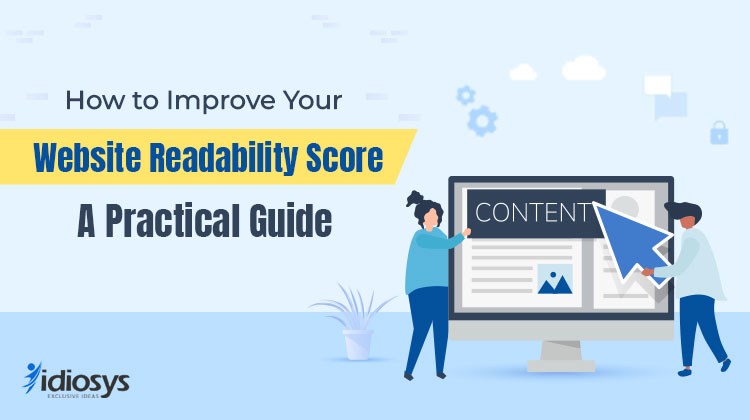
30 Oct, 2023
Web content is one of the most important factors of digital marketing strategy that influence your online success. It can attract, inform, and persuade your audience. But to do that, your web content needs to be readable. Readability is the measure of how easy it is for your readers to understand and enjoy your content. It depends on various elements, such as word choice, sentence structure, paragraph length, and formatting. A high readability score means your content is clear, concise, and engaging.
Readability is not only important for your readers, but also for your website. Readability can affect your website's performance in several ways, such as:
User engagement: Readable content can keep your readers interested and involved. It can reduce bounce rates and increase the time spent on your website.
Accessibility: Readable content can make your website more inclusive and accessible. It can ensure that people with different literacy levels and cognitive abilities can access and comprehend your information.
SEO benefits: Readable content can improve your website's ranking on search engines with right strategy from a SEO agency. Search engines like Google consider user experience as a key factor for ranking websites. Readable content can provide a better user experience and boost your website's visibility and traffic.
Brand credibility: Readable content can enhance your website's credibility and reputation. It can show that you care about your audience and communicate effectively. Readable content can build trust and loyalty among your readers.
Measuring Your Website Readability Score: The website readability score is a crucial metric that gauges how easy it is for visitors to understand and engage with your content. By regularly assessing your website readability score, you can identify areas for improvement and ensure that your content remains accessible and appealing to a diverse audience.
So, how can you improve your website's readability score? Here are some practical tips that you can follow:
Choose a reader-friendly font and size: Use a font that is easy to read and a size that is comfortable for your eyes. Avoid fonts that are too fancy or too small. A good rule of thumb is to use a font size of at least 16 pixels for body text. Sans-serif fonts, such as Arial and Calibri, are usually preferred for online content.
Maintain consistent formatting: Use the same font, size, and colour throughout your website. Use headings, subheadings, and bullet points to organize your content and create a hierarchy. Use bold, italic, and underline sparingly and only for emphasis. Consistent formatting can improve readability and coherence.
Break content into chunks: Avoid long blocks of text that can overwhelm your readers. Break your content into short paragraphs and use subheadings to introduce each section. Each paragraph should have one main idea and support it with relevant details. Short paragraphs can make your content easier to scan and understand.
Mind your sentence structure: Use simple and clear sentences that convey your message effectively. Avoid using complex words and sentences that can confuse your readers. Shorter sentences are generally easier to read than longer ones. Vary your sentence lengths to create a natural flow and rhythm.
Use bullet points and lists: Bullet points and numbered lists can help you present information in a concise and structured way. They can be useful when you want to list items, steps, or key points. Bullet points and lists can provide a visual break and make your content more appealing.
Incorporate white space: White space, or the empty space around the elements on your page, can enhance readability by creating contrast and balance. White space can prevent visual clutter and allow your readers to focus on your content. White space can also create a sense of openness and simplicity on your website.
Optimize images and media: Images and media can complement your content and make it more attractive and engaging. Use images and media that are relevant, high-quality, and properly sized. Use descriptive alt text for images to improve accessibility and SEO. Images and media can break up text and add interest to your content.
Utilize readability tools: There are many online tools that can help you assess and improve the readability of your content. Tools such as Yoast SEO, Grammarly, and Hemingway Editor can analyse your text and provide suggestions to enhance readability. They can also give you a readability score based on various formulas and metrics. You can use these tools to check and improve your content before publishing it.
Know your audience: The most important factor for readability is your audience. You need to know who you are writing for and what they expect from your content. Consider their level of knowledge, interest, and preference. Write in a tone and style that suits your audience and your purpose. Knowing your audience can help you create content that is relevant and appealing to them.
Test and iterate: The best way to improve your website's readability score is to test and iterate. Use analytics to track how your readers interact with your content. Measure metrics such as bounce rate, time on page, and conversions. Based on the data, make changes and improvements to your content. Test and iterate until you achieve your desired readability score and user experience.
Readability is a key aspect of web content marketing that can affect your website's performance and success. By following these tips, you can improve your website's readability score and provide a better user experience for your audience. Readability is not just about writing; it's about connecting and communicating with your readers. So, start improving your website's readability score today and see the difference it can make.
We, Idiosys Technologies, are a leading digital marketing company in Kolkata. We provide comprehensive services to numerous clients worldwide. We are also a leading SEO company in Kolkata, our team of highly skilled and experienced developers, including top SEO experts and digital marketing experts, know the ins and outs of online marketing strategies to guide you through.
---------------------------------------------------------------------------------------------------------------
Why is readability important for a website?
Good readability improves user experience, keeps visitors engaged, and helps convey your message clearly.
What factors affect readability?
Sentence length, word choice, paragraph structure, and formatting affect readability.
What type of words should I use to improve readability?
Use simple, everyday words that your audience will easily understand.
How can images improve readability?
Images break up text, illustrate points, and make content more engaging.
Can readability affect SEO?
Yes, good readability can improve user engagement and reduce bounce rates, positively impacting SEO.
How can I use visuals to improve readability?
Use charts, infographics, and images to support text and convey information more clearly.
What is the role of readability in content marketing?
Readable content is more likely to engage and retain readers, making it more effective for content marketing.
---------------------------------------------------------------------------------------------------------------
You May Also Read
Top 10 Tools For Optimizing Your Business Site

